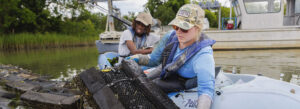Survey shows flooding risks and realities in three Hampton neighborhoods
Storm surge and flooding from hurricanes can damage homes, but nuisance flooding, a more common occurrence in Hampton Roads, can create problems like school delays, longer commutes, and business closures. Floodplain maps and census data can indicate which communities may be more vulnerable to flooding, but they can’t fully show how neighborhoods experience flooding.
To document the flooding experiences of local residents, a research team surveyed three historic neighborhoods in Hampton, Virginia, that are vulnerable to flooding. The study was conducted by a collaborative research team from Old Dominion University and Virginia Tech through a 4-VA grant, a program that promotes collaboration across Virginia Universities.
The project expanded on previous research done by Virginia Tech students as a part of 2017 Resilience Research & Design Collaborative Laboratory (Collaboratory) in partnership with Virginia Sea Grant, Wetlands Watch, and Virginia Green Builders.
“There’s a growing need to understand problems people might have due to flooding that are less measurable and visible,” said Anamaria Bukvic, a Virginia Tech Assistant Professor of Geography. “It can just be inconvenience or interruption in their daily activities due to flooding.”
The survey asked residents about their experiences with flooding, adaptive measures they have taken to increase their resilience, and future adaptations they would be willing to consider. Homeowners also rated their ability to cope with flooding, and what flood impacts would cause them to consider relocation.
All three neighborhoods are located in higher-risk FEMA special flood zones, within three miles of local waterways. The three neighborhoods, Fox Hill and Grandview, Phoebus and Fort Monroe, and Buckroe and Salt Ponds, were chosen for their unique history and culture.
“We wanted to see if those characteristics really affect how people feel about their vulnerability to flooding,” Bukvic said.
Across the neighborhoods, residents living in areas exposed to more flooding rated their vulnerability as higher and were generally more confident in their ability to cope with flooding. School delays and closures due to flooding was the most-reported issue, followed by longer work commutes, business closures, and yard and home damage. Two hundred residents completed the survey, which was conducted during the summer of 2019.
As part of the survey, the researchers also recorded first-floor home elevations, the type of foundation, and other home adaptations like flood vents or raised appliances. The City of Hampton will use this information to get a more detailed understanding about neighborhood-level resilience within the city.
“There’s a growing need to understand problems people might have due to flooding that are less measurable and visible,” Bukvic said.
“We wanted to see if those characteristics really affect how people feel about their vulnerability to flooding,” Bukvic said.
Since the geographic area is relatively flat, the experience of one household can be very different from the flood experience several houses down the road.
“So much of it depends on how the land slopes and the elevation,” said Aaron Whittemore, a Virginia Tech geography student who conducted surveys. “This area is so flat that if you’re just a little bit up a slope, you’re fine.”
As part of the project, a group of ODU and Virginia Tech students were also trained to understand coastal flood-related issues and resilience, conduct the survey, and analyze survey results.
“It has been totally different than any type of research I’ve done in school,” said Lenzie Ward, an ODU student who participated in the project. “It’s interesting to hear peoples’ stories.”
Takeaways:
- Researchers from Virginia Tech and Old Dominion University surveyed residents of three historic neighborhoods in Hampton, Virginia, that are vulnerable to flooding.
- The survey, based off previous research in the area, is one of the first to document the flooding experiences in these neighborhoods.
- School delays and closures due to flooding was the most-reported issue, followed by longer work commutes, business closures, and yard and home damage.
- The City of Hampton will use this information to get a more detailed understanding about neighborhood-level resilience within the city.
Photos and video by Aileen Devlin | Virginia Sea Grant
Story by Madeleine Jepsen | Virginia Sea Grant
Published Aug. 7, 2020.
Residents living in areas exposed to more flooding rated their vulnerability as higher and were generally more confident in their ability to cope with flooding.





